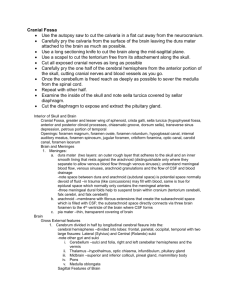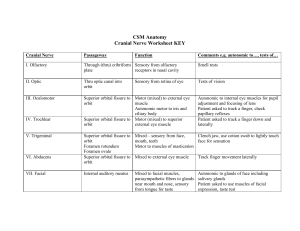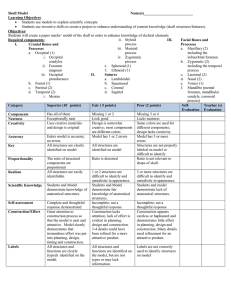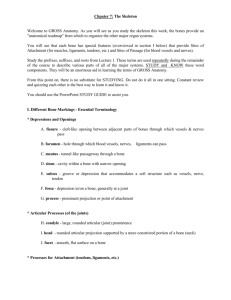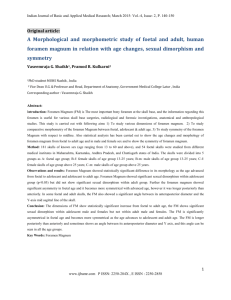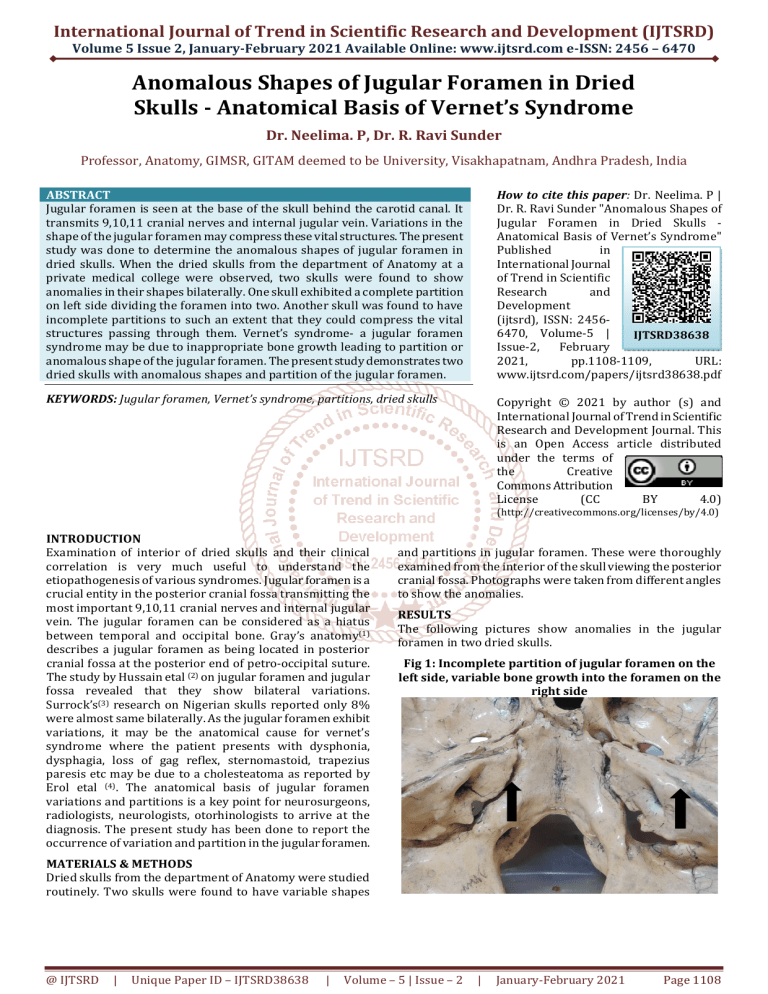
International Journal of Trend in Scientific Research and Development (IJTSRD)
Volume 5 Issue 2, January-February 2021 Available Online: www.ijtsrd.com e-ISSN: 2456 – 6470
Anomalous Shapes of Jugular Foramen in Dried
Skulls - Anatomical Basis of Vernet’s Syndrome
Dr. Neelima. P, Dr. R. Ravi Sunder
Professor, Anatomy, GIMSR, GITAM deemed to be University, Visakhapatnam, Andhra Pradesh, India
ABSTRACT
Jugular foramen is seen at the base of the skull behind the carotid canal. It
transmits 9,10,11 cranial nerves and internal jugular vein. Variations in the
shape of the jugular foramen may compress these vital structures. The present
study was done to determine the anomalous shapes of jugular foramen in
dried skulls. When the dried skulls from the department of Anatomy at a
private medical college were observed, two skulls were found to show
anomalies in their shapes bilaterally. One skull exhibited a complete partition
on left side dividing the foramen into two. Another skull was found to have
incomplete partitions to such an extent that they could compress the vital
structures passing through them. Vernet’s syndrome- a jugular foramen
syndrome may be due to inappropriate bone growth leading to partition or
anomalous shape of the jugular foramen. The present study demonstrates two
dried skulls with anomalous shapes and partition of the jugular foramen.
How to cite this paper: Dr. Neelima. P |
Dr. R. Ravi Sunder "Anomalous Shapes of
Jugular Foramen in Dried Skulls Anatomical Basis of Vernet’s Syndrome"
Published
in
International Journal
of Trend in Scientific
Research
and
Development
(ijtsrd), ISSN: 24566470, Volume-5 |
IJTSRD38638
Issue-2,
February
2021,
pp.1108-1109,
URL:
www.ijtsrd.com/papers/ijtsrd38638.pdf
KEYWORDS: Jugular foramen, Vernet’s syndrome, partitions, dried skulls
Copyright © 2021 by author (s) and
International Journal of Trend in Scientific
Research and Development Journal. This
is an Open Access article distributed
under the terms of
the
Creative
Commons Attribution
License
(CC
BY
4.0)
(http://creativecommons.org/licenses/by/4.0)
INTRODUCTION
Examination of interior of dried skulls and their clinical
correlation is very much useful to understand the
etiopathogenesis of various syndromes. Jugular foramen is a
crucial entity in the posterior cranial fossa transmitting the
most important 9,10,11 cranial nerves and internal jugular
vein. The jugular foramen can be considered as a hiatus
between temporal and occipital bone. Gray’s anatomy(1)
describes a jugular foramen as being located in posterior
cranial fossa at the posterior end of petro-occipital suture.
The study by Hussain etal (2) on jugular foramen and jugular
fossa revealed that they show bilateral variations.
Surrock’s(3) research on Nigerian skulls reported only 8%
were almost same bilaterally. As the jugular foramen exhibit
variations, it may be the anatomical cause for vernet’s
syndrome where the patient presents with dysphonia,
dysphagia, loss of gag reflex, sternomastoid, trapezius
paresis etc may be due to a cholesteatoma as reported by
Erol etal (4). The anatomical basis of jugular foramen
variations and partitions is a key point for neurosurgeons,
radiologists, neurologists, otorhinologists to arrive at the
diagnosis. The present study has been done to report the
occurrence of variation and partition in the jugular foramen.
and partitions in jugular foramen. These were thoroughly
examined from the interior of the skull viewing the posterior
cranial fossa. Photographs were taken from different angles
to show the anomalies.
RESULTS
The following pictures show anomalies in the jugular
foramen in two dried skulls.
Fig 1: Incomplete partition of jugular foramen on the
left side, variable bone growth into the foramen on the
right side
MATERIALS & METHODS
Dried skulls from the department of Anatomy were studied
routinely. Two skulls were found to have variable shapes
@ IJTSRD
|
Unique Paper ID – IJTSRD38638
|
Volume – 5 | Issue – 2
|
January-February 2021
Page 1108
International Journal of Trend in Scientific Research and Development (IJTSRD) @ www.ijtsrd.com eISSN: 2456-6470
Fig 2: Complete partition of jugular foramen on left
side as compared to normal foramen on right side.
REFERENCES
[1] Williams PL, Bannister LH, Berry MM, Collins P, Dyson
M, Dussek JE, et al. Gray's anatomy. 38 th ed.
Edinburg: Churchill Livingstone; 1995. p. 567
[2]
Hussain Saheb S, Mavishetter G. F., Thomas S T.,
Prasanna L. C., Muralidhar P. Morphological variations
in the structure of the jugular foramen of the human
skulls of south India., Biomedical Research (2010)
Volume 21, Issue 4.
[3]
Sturrock RR (1988) Variations in the structure of the
jugular foramen of the human skull. Journal of
Anatomy 160, 227-230.
DISCUSSION
The jugular foramen is not only a complicated entity for
surgical approach but also it transmits vital stuctures like
9,10,11 cranial nerves and internal jugular vein. The size and
shape of the foramen may be determined by the anatomical
morphology of internal jugular vein. A study by Hatilboglu
and Anil (5) on Anatolian skulls reported unequal sized
jugular formina on both sides. Ekinci etal (6) observed a
higher incidence of 61.4%. Wyoscki etal (7) described the
asymmetry between right and left foramina. Though the
literature was less on Indian studies, Patel and Singel (8)
reported bilateral variations in jugular foramina and fossae
as well. Another study by Sethi etal (9) concluded that the
jugular foramen was larger on the right side in 53.5% skulls
and on the left side in 7.1% skulls. The anatomical variations
in jugular foramen forms the basis of Vernet’s syndrome or
jugular foramen syndrome as described by Robbins etal (10).
The present study reports the occurrence of anomalies in the
jugular foramen in two dried skulls. One skull exhibited an
incomplete partition on one side with irregular bone growth
into the foramen on the other side. The second skull showed
a complete partition where the foramen is divided into two.
[4]
Erol FS, Kaplan M, Kavakli A, Ozveren MF. Jugular
foramen syndrome caused by choleastatoma. Clin
Neurol Neurosurg. 2005 Jun; 107(4):342-6. PubMed
PMID: 15885397.
[5]
Hatilboglu M. T & Anil A. Structural variations in the
jugular foramen of the skulls, Journal of Anatomy.
1992:180:191-196.
[6]
Ekinci N, Unur E. Macroscopic and morphometric
investigation of the jugular foramen of human skull. J
Anat 1997; 72:525-9.
[7]
Wyoscki J, Sharifi M. The occurrence variation and
diameter of human condylar canal in relation to
jugular foramen. Folia morphologica warsz Poland
Feb 2006.
[8]
Patel & Singel. Variations in the structure of jugular
foramen of the human skull in Saurashtra Region. J.
Anat. Soc. India. 2007:56 (2): 34-37.
[9]
Sethi R, Singh V, Kaul NV. Morphological variations of
a jugular foramen in North Indian human adult skulls.
Indian J Otol 2011; 17:14-6
CONCLUSION
Jugular foramen of two dried skulls showed incomplete and
complete partition on left side and an irregular bone growth
into the foramen on right side in one skull.
[10]
Robbins KT, Fenton RS. Jugular foramen syndrome. J
Otolaryngol. 1980 Dec; 9(6):505-16. PubMed PMID:
7206037.
@ IJTSRD
|
Unique Paper ID – IJTSRD38638
|
Volume – 5 | Issue – 2
|
January-February 2021
Page 1109

